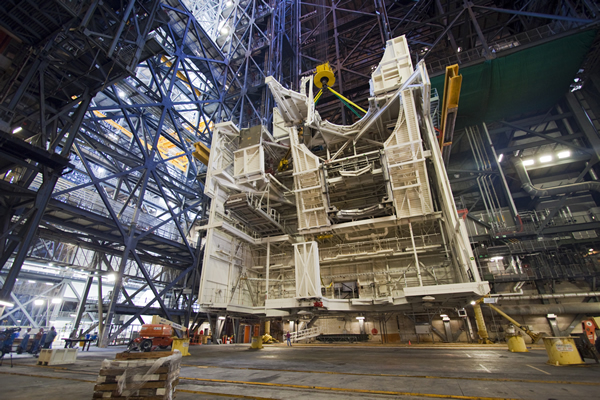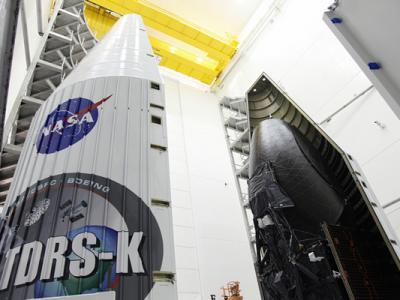Kennedy Space Center 2013
Image above: As part of Ground Systems Development and Operations Program work at Kennedy Space Center, space shuttle-era work platforms are removed from high bay 3 in the Vehicle Assembly Building on Oct. 24. All platforms were removed two days later.
Inside the Astrotech payload processing facility near NASA's Kennedy Space Center in Florida, technicians move one half of the payload fairing into place over the Tracking and Data Relay Satellite, TDRS-K.
Kennedy Space Center continues to serve as NASA's lead center for several programs and offices while transforming into a joint commercial and government launch complex.
"This is an exciting time as we continue to prepare the center for future space exploration programs," said Kennedy Center Director Bob Cabana. "We are making great progress toward a viable commercial spaceflight program and developing a heavy-lift capability that will allow us to once again send humans to explore beyond planet Earth."
NASA's Commercial Crew Program (CCP), based at Kennedy, is collaborating with the American aerospace industry as it designs and develops U.S. crew transportation capabilities to and from low-Earth orbit and the International Space Station. Throughout the year, CCP will support its three Commercial Crew Integrated Capability (CCiCap) partners, The Boeing Company, Space Exploration Technologies (SpaceX) and Sierra Nevada Corp. (SNC) Space Systems, as they work on fully integrated crew transportation systems, including launch vehicles, spacecraft, and ground and recovery operations.
The CCP Certification Products Contract (CPC) phase began Jan. 22 and will run concurrently with CCiCap, allowing the agency's partner companies to bring their designs within NASA's safety and performance expectations for future flights to the station. Late last year, NASA awarded contracts for the first phase of certification efforts to the same three partners participating in CCiCap.
Boeing is expected to begin manufacturing its crew transportation system in one of Kennedy's former orbiter processing facilities while its subcontractor United Launch Alliance begins constructing a crew access arm and escape system at Cape Canaveral Air Force Station's (CCAFS) Atlas V launch pad. SpaceX also will continue to work on upgrading its CCAFS launch pad for crewed missions. SNC, which also will launch its spacecraft on an Atlas V from the Space Coast, plans to utilize Kennedy's Shuttle Landing Facility for future runway landings.
The Ground Processing Directorate begins the year by implementing the newly awarded Test and Operations Support Contract (TOSC). NASA will work with the new contractor, Jacobs Technology Inc. to achieve overall management and implementation of ground systems capabilities, flight hardware processing and launch operations, as it transitions from the previous Checkout, Assembly and Payload Processing Services and Space Program Operations contracts. Ground Processing will provide day-to-day operations management and logistics support for launch complex and spacecraft/payload processing assets in support of program customers and implement a launch complex operations approach that supports users from NASA, commercial industry and other government agencies.
In support of NASA's core programs, Ground Processing will host the Launch Services Program for the upcoming Mars Atmosphere and Volatile Evolution (MAVEN) mission in November. The directorate also will work to prepare, test, and provide on-time delivery of space flight hardware to U.S. and international launch service providers for delivery to the International Space Station. It also will provide technical products and services to the Ground Systems Development and Operations (GSDO) Program to help develop Kennedy's launch complex infrastructure.
In 2013, GSDO will continue to prepare the Vehicle Assembly Building to support a variety of launch vehicle and spacecraft processing scenarios, including NASA’s Space Launch System and Orion spacecraft. GSDO will upgrade the 175-ton crane, complete the High Bay 3 platform design and award the Firex pumping and piping systems upgrade project.
GSDO also will develop a new command and control system for Firing Room 1, also known as the Young-Crippen Firing Room, in the Launch Control Center and continue a concept development study for an emergency egress system for Launch Pad 39B.
Assembly, integration and checkout will be completed on NASA’s Orion crew module for Exploration Flight Test 1 (EFT-1) in the Operations and Checkout Building high bay. Once completed, the spacecraft will be transported to Astrotech in Titusville for fuel servicing. EFT-1 will be launched on a United Launch Alliance Delta IV rocket in 2014. At the end of the test flight, GSDO will recover the module after it splashes down in the Pacific Ocean.
LSP is busy preparing for the agency's next launch, Tracking and Data Relay Satellite-K (TDRS-K), aboard a United Launch Alliance Atlas V rocket from Launch Complex 41, Jan. 30.
TDRS-K is the first of three next-generation satellites that have improved solar panels that will provide more power to the spacecraft, expand the lifespan of the fleet and allow the TDRS system to service more customers with different and evolving communication requirements.
Two weeks later, LSP will support the launch of NASA's Landsat Data Continuity Mission (LDCM) spacecraft aboard a ULA Atlas V rocket from Space Launch Complex-3 at Vandenberg Air Force Base in California.
LDCM is a NASA and U.S. Geological Survey mission that will continue a 40-year record of measuring change on the planet from space. The spacecraft was built and tested by Orbital Sciences Corp.
NASA's next launch, aboard an Orbital Sciences Pegasus XL rocket, will be in late April when the agency's Interface Region Imaging Spectrograph spacecraft launches from Vandenberg.
Throughout the year, LSP will continue to support advance planning for about 20 missions that are in the early stages of formulation and provide integration services for 12 missions already under contract, including those scheduled for 2013. The program also will continue in an advisory role for Commercial Resupply missions based at Johnson Space Center, and collaborate with CCP.
The International Space Station Ground Processing and Research Project Office will focus on developing science experiments, testing a new Nitrogen Oxygen Recharge System (NORS) and processing orbital replacement units.
This year, the office will work to develop a variety of science experiments for future delivery to the station, including the Biologic Research in Canisters (BRIC) series of experiments, BRIC-17, the Biotube, BRIC-18 and the Advanced Plant Experiment (APEX) flying on future commercial resupply missions.
Inside the Space Station Processing Facility, several orbital replacement units for the station are being processed and prepared for shipment to Tanegashima, Japan, in February in support of the HTV-4 cargo resupply flight to the orbiting laboratory.
During the year, testing will commence on NORS, which is a composite over-pressurized vessel used for recharging space station airlock tanks for use in preparation for Extra Vehicular Activities (EVAs).
The office will provide support for the Advanced Plant Habitat and the testing and integration of other station payloads, including the Stratospheric Aerosol and Gas Experiment-III sponsored by Langley Research Center in Hampton, Va., and the Optical Payload for Lasercomm Science (OPALS) sponsored by the Jet Propulsion Laboratory (JPL) in Pasadena, Calif.
OPALS will demonstrate optical communication by transferring a video from the payload on the station to a ground receiver at JPL's Optical Communications Telescope Laboratory in Wrightwood, Calif.
Linda Herridge
NASA's John F. Kennedy Space Center













